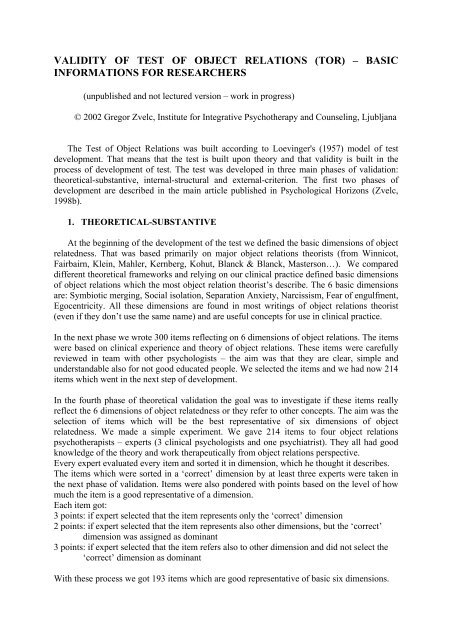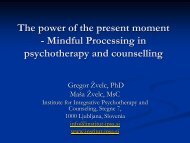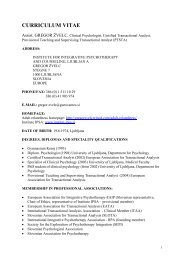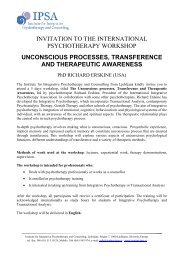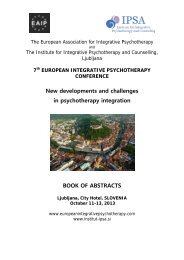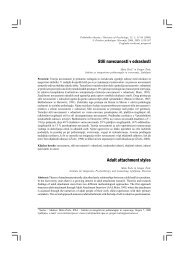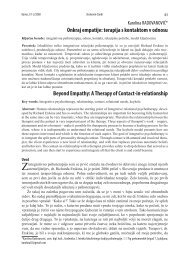VALIDITY OF TEST OF OBJECT RELATIONS (TOR) - IPSA
VALIDITY OF TEST OF OBJECT RELATIONS (TOR) - IPSA
VALIDITY OF TEST OF OBJECT RELATIONS (TOR) - IPSA
You also want an ePaper? Increase the reach of your titles
YUMPU automatically turns print PDFs into web optimized ePapers that Google loves.
<strong>VALIDITY</strong> <strong>OF</strong> <strong>TEST</strong> <strong>OF</strong> <strong>OBJECT</strong> <strong>RELATIONS</strong> (<strong>TOR</strong>) – BASICINFORMATIONS FOR RESEARCHERS(unpublished and not lectured version – work in progress)© 2002 Gregor Zvelc, Institute for Integrative Psychotherapy and Counseling, LjubljanaThe Test of Object Relations was built according to Loevinger's (1957) model of testdevelopment. That means that the test is built upon theory and that validity is built in theprocess of development of test. The test was developed in three main phases of validation:theoretical-substantive, internal-structural and external-criterion. The first two phases ofdevelopment are described in the main article published in Psychological Horizons (Zvelc,1998b).1. THEORETICAL-SUBSTANTIVEAt the beginning of the development of the test we defined the basic dimensions of objectrelatedness. That was based primarily on major object relations theorists (from Winnicot,Fairbairn, Klein, Mahler, Kernberg, Kohut, Blanck & Blanck, Masterson…). We compareddifferent theoretical frameworks and relying on our clinical practice defined basic dimensionsof object relations which the most object relation theorist’s describe. The 6 basic dimensionsare: Symbiotic merging, Social isolation, Separation Anxiety, Narcissism, Fear of engulfment,Egocentricity. All these dimensions are found in most writings of object relations theorist(even if they don’t use the same name) and are useful concepts for use in clinical practice.In the next phase we wrote 300 items reflecting on 6 dimensions of object relations. The itemswere based on clinical experience and theory of object relations. These items were carefullyreviewed in team with other psychologists – the aim was that they are clear, simple andunderstandable also for not good educated people. We selected the items and we had now 214items which went in the next step of development.In the fourth phase of theoretical validation the goal was to investigate if these items reallyreflect the 6 dimensions of object relatedness or they refer to other concepts. The aim was theselection of items which will be the best representative of six dimensions of objectrelatedness. We made a simple experiment. We gave 214 items to four object relationspsychotherapists – experts (3 clinical psychologists and one psychiatrist). They all had goodknowledge of the theory and work therapeutically from object relations perspective.Every expert evaluated every item and sorted it in dimension, which he thought it describes.The items which were sorted in a ‘correct’ dimension by at least three experts were taken inthe next phase of validation. Items were also pondered with points based on the level of howmuch the item is a good representative of a dimension.Each item got:3 points: if expert selected that the item represents only the ‘correct’ dimension2 points: if expert selected that the item represents also other dimensions, but the ‘correct’dimension was assigned as dominant3 points: if expert selected that the item refers also to other dimension and did not select the‘correct’ dimension as dominantWith these process we got 193 items which are good representative of basic six dimensions.
114 of 193 items got 12 points – that means that all experts agreed that these items describeonly one dimension of object relatedness.2) INTERNAL-STRUCTURAL VALIDATIONWe conducted a research aimed at selection of items that would satisfy theoretical andalso psychometric criteria (Zvelc, 1998b). In the research participated 118 university students(age from 18 till 36). They all completed the first version of Test of Object Relations, whichat that point consisted of 193 items. All these items already went through the theoreticalsubstantivephase of validation and were found to be theoretically valid by at least threeexperts in object-relations theory.a) Selection of itemsWe made the selection of the items with the help of the procedure Reliabilities (SPSS forWindows, ver 6.0). Selection of the items was conducted in subsequent steps whichincorporated psychometric as well as theoretical criteria (see also Jackson (1970, 1971).1. Phase of selectionIn the first phase we analyzed the corrected correlations of each item with its ‘maternal 1 ’scale. If the correlation was smaller than 0,20, the item was eliminated. These correlationswere not significant and contributed to low internal consistency of the scale.2. Phase of selectionIn the second phase we were interested in correlations of each item with non-maternal scales.If the item correlated higher with the total score of the non-maternal scale than with thematernal scale, the item was eliminated. These procedure helps to establish convergent anddiscriminant validity of the scale (Jackson, 1970).3. Phase of selectionIn these phases we acknowledge both the theoretical and psychometric criteria for selection.If the corrected correlation of each item with the maternal scale was low (0,20-0,30) and wasalso theoretically weak (7-9 points), we eliminated it. We were also careful that itemsrepresented the whole continuum of dimension. Because of that we kept some items whichwere theoretically very important even if they didn’t have very strong correlation with thematernal scale. We were also attentive about inter-item correlations - we eliminated itemswhich had very strong correlations and were also theoretically very similar.After described selection of the items we got 90 items which satisfied theoretical as well thepsychometric criteria. We also wrote additional 5 items to reflect the social desirability andrandom answering.b) Reliability of the Test of Object Relations1.) Internal consistency (See Instructions for use)1 Maternal scale is a scale for which the item was written.
2.) Test-retest reliability (unpublished results)We conducted a research on 21 students (13 man and 8 female). They completed Test ofObject Relations in three week interval.Test-retest reliability for each scale was:Symbiotical merging: 0,76Separation Anxiety: 0,84Narcissizem: 0,92Egocentricity: 0,65Fear of Engulfment: 0,84Social Isolation: 0,65We are currently conducting studies of reliability on other populations.3.) EXTERNAL VALIDATIONThe first published study which speaks about the external validity of the <strong>TOR</strong> was thearticle ‘Object relations among the drug addicts’ (Zvelc, 2000). The research compared 90patients on methadone and 90 people from control group, equated with gender, age andeducation. The Test of Object Relations showed that patients on methadone have significantlyhigher scores on all scales of object relations. The findings are consistent with theoretical andclinical observations of many object relations writers.Another study which speaks about the external validity of the <strong>TOR</strong> came from the researchinvestigating the impact of psychotherapy on the group of volunteers (Kobal, 2001).The Test of Object Relations was used before the psychotherapy treatment, immediately afterthe treatment and one month ahead. The research showed that the Test of Object Relations isvery useful in measuring the effects of the psychotherapy.At the moment we have conducted a major research project for further validation of <strong>TOR</strong>. Weare currently investigating the results and interpreting data. The <strong>TOR</strong> was used together withmany other instruments which measure theoretically related constructs (personality disorders,parental representations measured with Parental bonding inventory, separation from parents,clinical diagnoses, self concept, big-five dimensions of personality…). We are alsodeveloping the norms for clinical population.Currently there is also lots of research going on with <strong>TOR</strong> by different authors on differentpopulations (sexual offenders, pregnant woman, people in family therapy, eating disorders…).Studies are not published yet.Loevinger, J. (1957). Objective tests as instruments of psychological theory. PsychologicalReports, 3, 635-694.Jackson, D. N. (1970). A sequential system for personality scale development. V C.D.Spielberger (Ur.), Current topics in clinical and community psychology. (Vol.2, str.61-96). New York: Academic Press.
Jackson (1971). The dynamics of structured personality tests. Psychological Review, Vol. 78,št. 3, 229-248.Kobal, L. (2001). Razvoj diadnih odnosov v kontekstu prostovoljske organizacije. Magistrskodelo. Ljubljana: Univerza v Ljubljani, Filozofska fakulteta, Oddelek za psihologijo.Žvelc, G. (1998b). Razvoj testa objektnih odnosov. The Development of the Test of ObjectRelations. Psihološka obzorja. Horizons of Psychology, vol.7, št.3, 51-67.Žvelc, G. (2000). Značilnosti objektnih odnosov oseb, ki so odvisne od drog. Characteristicsof the object relations of drug addicts (Summary). Odvisnosti. Leto 1, štev. 1-2,str. 21-27.BASIC REFERENCES FOR <strong>TOR</strong> AND PTSI:Žvelc, G. (1998b). Razvoj testa objektnih odnosov. The Development of the Test of ObjectRelations (<strong>TOR</strong>). Psihološka obzorja. Horizons of Psychology, vol.7, št.3, 51-67.Žvelc, G. in Žvelc, M. (2000). Slikovni test separacije in individualizacije.Preliminarna raziskava. Picture test of Separation and Individuation. Psihološkaobzorja. Horizons of Psychology, 9(2), 33-52.Žvelc, M. (2003). Razvoj slikovnega testa separacije in individualizacije. Developemnt ofPicture Test of Separation and Individuation. Ljubljana: Filozofska fakulteta.Magistrsko delo (MsC).BIBLIOGRAFIJA TOO IN STSI:Bogataj, T. (2003). Objektno-relacijske karakteristike žensk, ki se odločajo prvo nosečnostumetno prekiniti. Diplomsko delo. Ljubljana: Univerza v Ljubljani, Filozofskafakulteta, Oddelek za psihologijo.Grošelj, R. (2003). Odvisnost od alkohola in objektni odnosi. Diplomsko delo. Ljubljana:Univerza v Ljubljani, Filozofska fakulteta, Oddelek za psihologijo.Kobal, L. (2001). Razvoj diadnih odnosov v kontekstu prostovoljske organizacije. Magistrskodelo. Ljubljana: Univerza v Ljubljani, Filozofska fakulteta, Oddelek za psihologijo.Rogič Ožek , S. (2004). Razvojni proces separacije in individualizacije pri gibalno oviranihosebah. Magistrsko delo. Ljubljana: Univerza v Ljubljani, Filozofska fakulteta,Oddelek za psihologijo.Jambrek, Š. K. (2004). Ali pri dvojčkih lahko govorimo o specifičnem razvoju objektnihodnosov. Diplomsko delo. Ljubljana: Univerza v Ljubljani, Filozofska fakulteta,Oddelek za psihologijo.Simonič, A. (2004). Proces žalovanja ob izgubi partnerja glede na način smrti..Diplomskodelo. Ljubljana: Univerza v Ljubljani, Filozofska fakulteta, Oddelek za psihologijo.Štirn, M. (2003). Oris osebnostnih značilnosti storilcev spolnih deliktov. Magistrskodelo. Ljubljana: Univerza v Ljubljani, Filozofska fakulteta, Oddelek za psihologijo.
Žvelc, G. (1998a). Proces separacije-individualizacije ter objektni odnosi priosebah, ki so odvisne od drog. Diplomsko delo. Ljubljana: Univerza v Ljubljani,Filozofska fakulteta, Oddelek za psihologijo.Žvelc, G. (1998b). Razvoj testa objektnih odnosov. Psihološka obzorja. Horizons ofPsychology, vol.7, št.3, 51-67.Žvelc, G. (2000). Značilnosti objektnih odnosov oseb, ki so odvisne od drog. Characteristicsof the object relations of drug addicts (Summary). Odvisnosti. Leto 1, štev. 1-2, str.21-27.Žvelc, G. in Žvelc, M. (2000). Slikovni test separacije in individualizacije.Preliminarna raziskava. Psihološka obzorja. Horizons of Psychology, 9(2), 33-52.Žvelc, M. (2003). Razvoj slikovnega testa separacije in individualizacije. Ljubljana:Filozofska fakulteta. Magistrsko delo.


